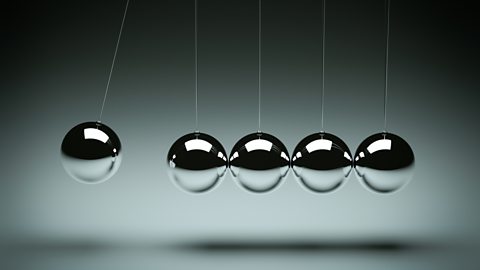What are light waves?
Light is a type of electromagnetic radiation that can be detected by the eye. It travels as a transverse wave. Unlike a sound waves, light waves do not need a medium to pass through, they can travel through a vacuum.
Light from the Sun reaches Earth through the vacuum of space.
A short video explaining the concept of light waves.
The speed of light
The speed of light in air is very close to 300 000 000 m/s. which is nearly a million times faster than the speed of sound, which is 340 m/s. 300 000 000 m/s is often written as 3 x \(10^8\) m/s.
The very large difference between the speed of light and the speed of sound explains why you:
- See lightning before you hear it.
- See a distant firework explode before you hear it.
- See a distant hockey stick hit a ball before you hear it.
Just how fast is 300 000 000 m/s?
300 000 000 m/s (or 300 million m/s) is approximately the same as 670 000 000 miles per hour (or 670 million miles per hour).
That means in one second light travels a distance of 300 000 000 m â which is about seven and half times around the world, in one second. Which is pretty fast! Not even Superman managed that. In fact, nothing can travel faster than the speed of light.
By comparison, sound travels just 340 m in one second, about the length of three and a half hockey pitches.

The table summarises some similarities and differences between light waves and sound waves:
| Light waves | Sound waves | |
|---|---|---|
| Type of wave | Transverse | Longitudinal |
| Can they travel through matter (solids, liquids and gases)? | Yes (if transparent or translucent) | Yes |
| Can they travel through a vacuum? | Yes | No |
| How are they detected? | Eyes, photographic film, light detectors or image sensors | Ears, microphones |
| Can they be reflected? | Yes | Yes |
| Can they be refracted? | Yes | Yes |
| Speed | 300 000 000 m/s (300 million m/s or 3 x \(10^8\) m/s) | 340 m/s |
Light rays and ray diagrams
Light travels in a straight line. When drawing a light ray:
- Use a ruler and a sharp pencil to draw a straight line.
- Add an arrow to show the direction the light is travelling.

A ray diagram shows how light travels, including what happens when it reaches a surface.
In a ray diagram, you draw each ray as:
- a straight line
- with an arrowhead pointing in the direction that the light travels
Remember to use a ruler and a sharp pencil.
Lasers are a good example of light travelling in straight lines.
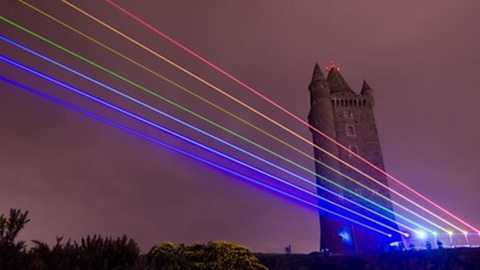
The pinhole camera
A pinhole camera consists of a box or tube with a translucent screen at one end and a tiny hole (the pinhole) made in the other end. Light enters the box through the pinhole and an image is formed on the translucent screen. The image is upside down and smaller than the object.
A pinhole camera is another good example of the fact that light travels in straight lines. They can be useful to look at the image of a dazzling object such as the Sun which you should never look at directly. Forming an image on the screen makes watching an eclipse safe.
Shadows
Shadows are also formed because light travels in straight lines. When an object that will not allow light to pass through it (an opaque object) is placed in front of a light, a shadow is cast on the ground or a screen behind it. The object stops the light reaching the ground and the shadow is the shape of the object.
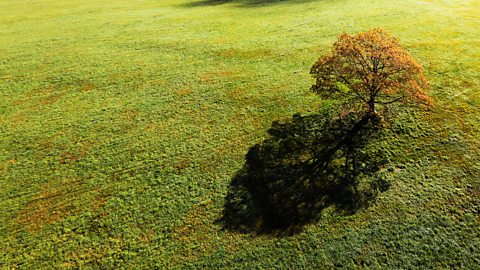
If light could curve around the tree, the shadow wouldnât form. A shadow shows that light travels in straight lines.
Solar eclipse
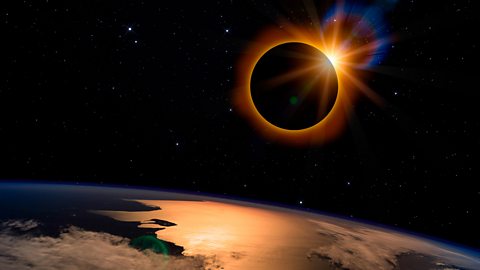
An eclipse of the Sun, or Solar Eclipse, occurs when a new Moon passes directly between the Sun and the Earth, blocking out the Sun's rays and casting a shadow on regions of the Earth. As a result, daylight briefly turns to darkness.
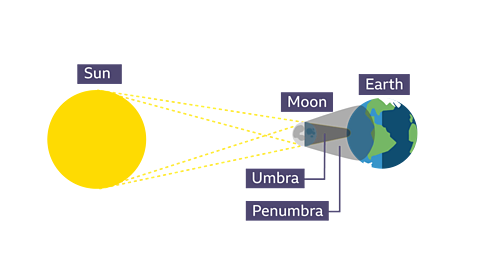
The total shadow or umbra is the shadow's dark core. The partial shadow or penumbra is the lighter outer part of the shadow.
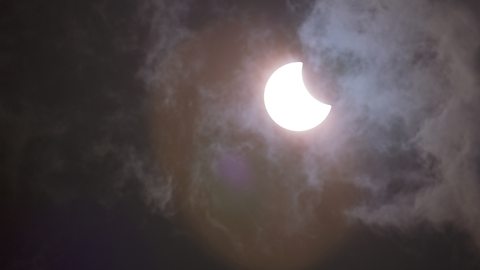
A total solar eclipse happens when the Moon casts the darkest part of its shadow, called the umbra, on Earth. The Moon appears to cover the entire disk of the Sun. However, you only see a total solar eclipse if you are in a region covered by the Moon's full shadow, its umbra. Those outside the path in the partial shadow, or penumbra, see a partial eclipse.
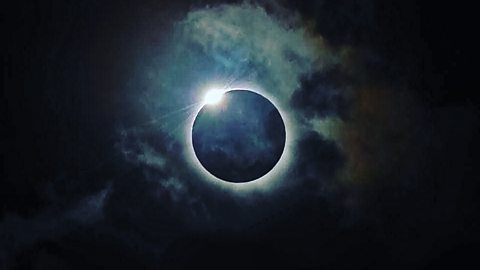
The next total solar eclipse to occur in the UK will be on 23 September 2090. It will be visible in Cornwall and much of the south coast of England and last 3 minutes and 36 seconds just minutes before sunset. Partial eclipse can be seen from parts of the UK on 10th June 2021, 25th October 2022, 8th April 2024 and the 29th March 2025.
Eclipse viewing safety
- Never look directly at the Sun: you can damage your eyes forever and even go blind.
- Never look at the Sun through binoculars or a telescope.
- Don't look directly at the Sun through sunglasses, a camera or your phone camera - none of these protect your eyes.
- To watch an eclipse, you will need to wear special glasses, properly darkened and filtered to protect your eyes. You can also safely view the image of an eclipse using a pinhole camera.
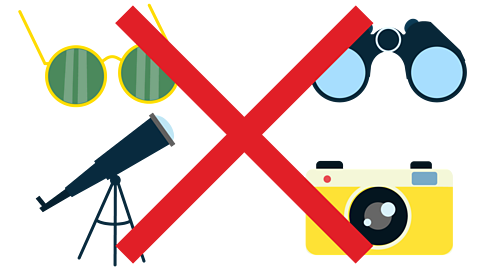
Luminous and non-luminous objects
We see something either because it emits its own light, or it reflects light.
An object that gives out, or emits, its own light is called a luminous object.
Examples of luminous objects include:
- the Sun
- stars
- fire
- candle flame
- laser
- light bulb
- luminous mushrooms
- fireflies
- some jellyfish
A non-luminous object does not give out its own light. We see it because it reflects the light from a luminous object, like the Sun or a candle, towards our eyes.

The book is a non-luminous object. You see it because it reflects light from the candle flame towards your eyes.
Other examples of non-luminous objects include:
- the Moon
- the planets
- the ground
- a person
- a wall
- a cat
- a whiteboard
Investigating reflection of light
Investigating reflection of light
A mirror reflects light. It is made by putting a thin reflecting layer behind a piece of glass. The reflecting layer is often silver nitrate, held in place by a coat of paint. Most every day mirrors are flat and are called plane mirrors.
In a ray diagram, the mirror is often drawn as a straight line with thick hatchings. The side with the hatchings indicates the non-reflective side.
The diagram shows a ray of light reflected from a plane mirror.
Some important new terms:
- The hatched vertical line on the left represents the plane mirror.
- The incident ray is the ray of light going towards the mirror.
- The reflected ray is the ray of light coming away from the mirror.
- The normal is a reference line drawn at right angles to the reflecting surface of the mirror.
- The angle of incidence, i, is the angle between the normal and incident ray.
- The angle of reflection, r, is the angle between the normal and reflected ray.
When measuring the angle of incidence, i, or angle of reflection, r, it is important to place the zero line of the protractor along the normal. This will ensure that you measure the angle between the normal and the ray and not the angle between the mirror and the ray.
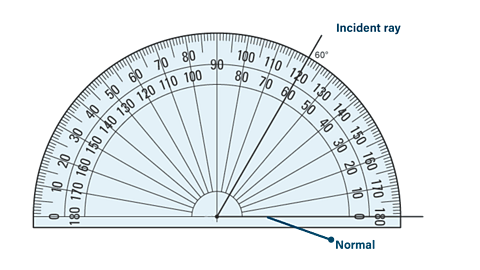
To investigate reflection from a plane mirror you will need a:
- plane mirror
- ray box
- low voltage power pack with a single slit comb
- sheet of white paper
- protractor
- 30 cm ruler
- sharp pencil
- On a sheet of white paper draw a pencil line â label this AB.
- Using a protractor, draw a normal at C, roughly the middle of AB.
- Draw a line at 20° to the normal.
- Position a plane mirror carefully along AB.
- Direct a single ray of light from a ray box along the 20° line â this is the incident ray. Record the angle of incidence i in a suitable table.
- Draw 2 pencil Xs to mark the position of the reflected ray.
- Take away the mirror and join these Xs back to C. This is the reflected ray. Put an arrow on it to show its direction away from the mirror.

- Measure the angle between the normal and the reflected ray with the protractor and record the angle of reflection r in the table. Make sure that the normal goes through the zero of the protractor.
- Repeat the experiment for a series of incident rays.
Risks/Hazards
| Hazard | Consequence | Control measures |
|---|---|---|
| Ray box gets hot | Minor burns | Do not touch bulb and allow time to cool before handling the ray box |
| Semi-dark room | Increased trip hazard | Ensure working area is clear of trip hazards |
Analysis
Compare the angle of incidence with the angle of reflection for each pair of readings.
Conclusion
It should be clear from your readings that when light is reflected from a plane mirror:
the angle of incidence, i = the angle of reflection, r
This is known as the law of reflection.
For example:
The angle of reflection is 30° if the angle of incidence is 30°.
The angle of reflection is 75° if the angle of incidence is 75°.
The angle of reflection is 0° if the angle of incidence is 0°.
In the third example, if a light ray travelling along the normal hits a mirror, it is reflected straight back along the normal, the way it came.
i = r
If a light ray hits the mirror with an angle of incidence of 45°, it will be reflected with an angle of reflection of 45°.
Specular reflection
Specular reflection
Reflection from a smooth, flat surface is called specular reflection.
This reflection obeys the law of reflection and is the type that happens with a flat mirror.
Properties of the image in a plane mirror
When an object is placed in front of a plane mirror an image is formed.
The image in a plane mirror is:
- upright â but left and right are reversed. We say that the image is laterally inverted
- the same height as the object
- as far behind the mirror as the object is in front
- virtual
A virtual image is an image from which rays of light appear to diverge, and do not actually pass through. A virtual image cannot be formed on a screen.
Notice that the ârealâ rays, the ones leaving the object and the mirror, are shown as solid lines. The âvirtualâ rays, the ones that appear to come from the image behind the mirror, are shown as dashed lines. Remember that each incident ray will obey the law of reflection.
Diffuse reflection
If a surface is rough, diffuse reflection happens. Instead of forming an image, the reflected light is scattered in all directions.
This may cause a distorted image of the object, as occurs with rippling water, or no image at all. Each individual reflection still obeys the law of reflection, but the different parts of the rough surface are at different angles and so the reflected rays are not parallel.
Question
What is the angle of reflection?
- The angle of incidence, i = 35°
- i = r and so the angle of reflection, r = 35°
Question
What is the angle of incidence?
- The angle of reflection, r = 32°
- i = r and so the angle of incidence, i = 32°
Question
What is the angle of reflection? (Be careful with this oneâŠ)
- The angle between the incident ray and the mirror = 52°
- So, the angle of incidence, i = 90° - 52° = 38°
- i = r and so the angle of reflection, r = 38°
Question
What is the angle of reflection from the second mirror?
- The angle of incidence at mirror A = 70°.
- i = r and so the angle of reflection at mirror A = 70°.
- The angle between the reflected ray and mirror A = 20° (as shown in green in the diagram). As this ray and the two mirrors make a triangle (as highlighted in red on the diagram), the angle between the ray and mirror B = 70° (as shown in purple on the diagram). We know this because the angles within a triangle add up to 180°. If two of the angles are 20° and 90°, the third must be 70°. This means that the angle of incidence at mirror B is equal to 20°.
- i = r and so the angle of reflection at mirror B = 20°.
The periscope
A periscope uses two mirrors to allow someone to look over an obstacle.
- Submarines use periscopes to see ships on the surface of the sea.
- Someone at the back of the crowd at a golf tournament or royal event might use one to see over the heads of those in front.
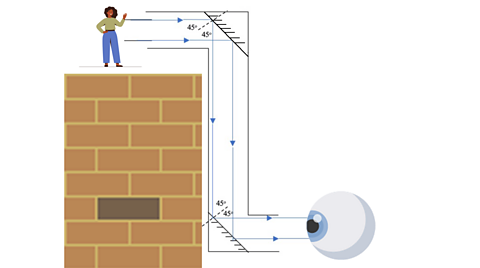
- The two mirrors are arranged at 45° as shown in the diagram.
- The angle of incidence at the first mirror is 45° and so the angle of reflection is 45°. The rays of light turn through a right angle.
- The same thing happens when the light hits the 2nd mirror, and the rays of light are again turned through 90°.
- The rays emerge parallel to the way they entered the periscope, and the image is upright.
Refraction of light
When light travels from air into glass it slows down because glass is more dense than air.
This change in speed can cause the light to bend at the boundary between the air and glass.
The change in direction of a beam of light as it travels from one material to another is called refraction.
The diagram shows refraction of light passing into, and then out of, a glass block. The same would happen for a Perspex block or for water.
Some important new terms:
Incident ray: the ray travelling towards the glass block.
Refracted ray: the ray inside the glass block.
Emergent ray: the ray travelling away from the glass block on the other side.
The normal is a reference line drawn at right angles to the surface of the glass block.
Angle of incidence i = angle between the incident ray and the normal.
Angle of refraction r = angle between the refracted ray and the normal.
Remember: Angles of incidence and refraction are always measured between the normal and the ray of light. Make sure that the normal goes through the zero of the protractor.
Investigating refraction
Apparatus
- low voltage power pack
- 12V ray box with a single slit comb
- rectangular glass block
- sheet of white paper
- protractor
- sharp pencil
Method.
- Place the rectangular glass block on a sheet of white paper and draw around it carefully with a pencil.
- Remove the glass block. Use the protractor to draw a normal approximately 1/3 of the way along the longest side.
- Use a protractor to measure angles of incidence from this normal of 10°, 20°, 30°, 40°, 50°, 60° and 70°. Draw in the incident rays corresponding to these angles and label them A, B, C⊠Record these angles of incidence in a suitable table.
- Carefully replace the block on the outline. Direct a narrow ray of light along the line marked A. This is the incident ray for the angle of incidence, i = 100.
- With the pencil mark two Xs to indicate the direction of the emergent ray. Mark the Xs as far apart as possible.
- Remove the block again. Join the Xs with a pencil line, drawn using a ruler. Extend this line back to the block. This is the emergent ray: label it 'A'.
- Use the ruler to join the incident and emergent rays together with a pencil line. This is the refracted ray. Carefully mark in the angle of refraction, r, between the refracted ray and the normal.
- Measure the angle of refraction with a protractor and record in the table.
- Measure the angle of emergence, e, with a protractor and record in the table.
- Repeat the procedure for each of the incident rays, recording angle of refraction and angle of emergence in the table.
Risks
| Hazard | Consequence | Control measures |
|---|---|---|
| Ray box gets hot | Minor burns | Do not touch bulb, allow time for ray box to cool before handling |
| Semi-dark environment | Increased trip hazard | Ensure work space is clear of trip hazards before lowering lights |
Analysis
Compare the size of the angle of refraction, r, with the angle of incidence, i.Compare the size of the angle of emergence, e, with the angle of refraction, r.
Conclusion
The angle of refraction is less than the angle of incidence. Therefore, when light travels from air into glass it bends towards the normal.
The angle of emergence is greater than the angle of refraction. Therefore, when light travels from glass into air it bends away from the normal.
Direction of refraction
Glass is denser than air, so when light passes from air into glass it slows down.
- The ray is bent towards the normal.
Light speeds up as it passes from glass into air because air is less dense than glass.
- The ray is bent away from the normal.
The greater the change of speed of light at a boundary, the greater the refraction. Light is bent more by glass than by water because glass is denser than water and so slows it down more.
One way of remembering the direction of refraction is to use the word FAST.
- If light gets Faster it bends Away from the normal.
- If light gets Slower it bends Towards the normal.
| Letter | Meaning | When this happens | Example |
|---|---|---|---|
| F | Faster | Dense to less dense | Glass to air or Water to air |
| A | Away | ||
| S | Slower | Less dense to dense | Air to glass or air to water |
| T | Towards |
If light is incident along the normal when it passes from air into glass it still slows down but its direction does not change â it passes straight through.
Likewise, if light is incident along the normal when it passes from glass into air it still speeds up but its direction does not change â it passes straight through.
Refraction explains why an object appears to bend when it goes through water.
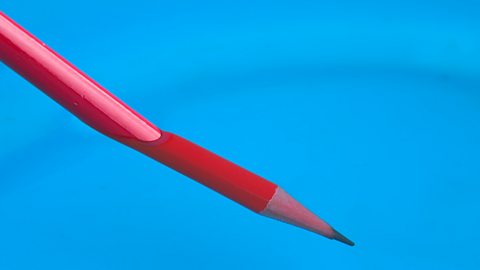
Refraction by a prism
The incident ray is refracted towards the normal as it enters the glass prism from air.
It is then refracted away from the normal at the boundary between glass and air as it leaves the prism.
A photographer explains the science of colour.
When white light passes through a prism it can be split up into its colours. The band of colours seen is called the spectrum of white light.
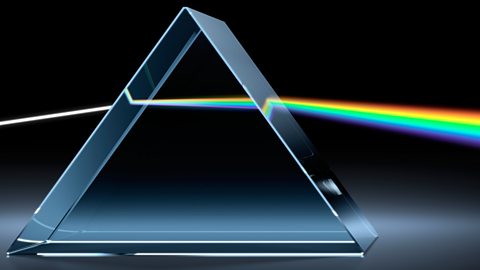
The spectrum is produced because different colours of light travel at different speeds in glass.This means that each colour of light is refracted by a different amount when it enters the glass and when it leaves.
- Red light is slowed down least by glass and is refracted least.
- Violet light is slowed down most by glass and is refracted most.
The splitting of white light into its colours in this way is called dispersion.
Here are the seven colours of the spectrum listed in order of their frequency, from the lowest frequency to the highest frequency:
- red
- orange
- yellow
- green
- blue
- indigo
- violet
One way to remember the order: âRichard Of York Gave Battle In Vainâ.These are the same colours seen in a rainbow. A rainbow is formed when sunlight shines through water. The tiny water droplets act as prisms, refracting each colour of the white light by a different amount, to produce the spectrum of light arched across the sky.
Professor Brian Cox explains how white light disperses into different colours.

Test yourself
Try your hand at putting colours in order of low to high frequency with this quick quiz.
Test your knowledge of light waves with this pop quiz!
More on Physics
Find out more by working through a topic
- count3 of 8
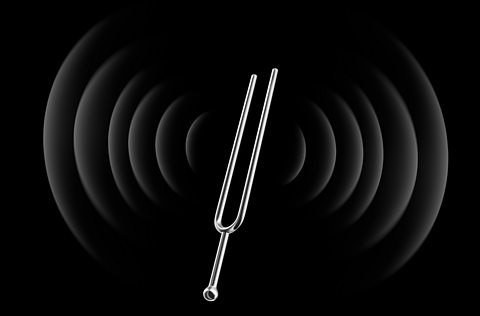
- count4 of 8
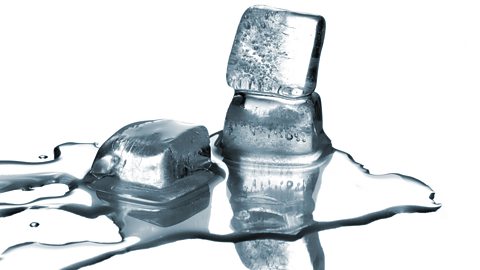
- count5 of 8

- count6 of 8
